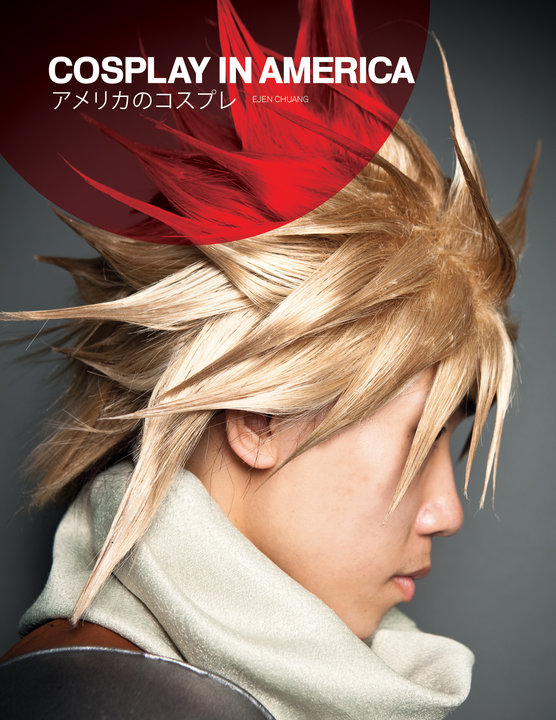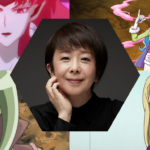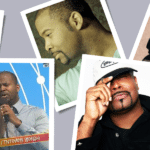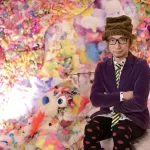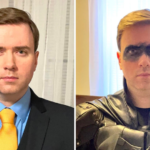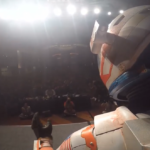Ejen Chuang is best known for his work as Cosplay in America, which is the name of his first Cosplay photography book, which he later expanded to include a second photography book, a forthcoming third book, and a vast array of interviews and stories with cosplayers of all walks of life featured on his website www.cosplayinamerica.com and the accompanying social media outlets.
I first met Ejen in person at Anime Weekend Atlanta as he was preparing his first photo book. After catching up this year, we agreed to interview one another. I asked in my interview with Ejen if he thought all these years later he would still be covering cosplay.
“No way,” Ejen responded. “Two years, maybe three years?” “We’re coming on to 14 years, I think I’m in this for life, I guess.”
Prior to working on his own book, Ejen had been an assistant photographer, photographing film sets, business workers, CEOs, and celebrities. Though this provided opportunities for Ejen, and work during the housing crisis, there was a limit to Ejen’s creativity with his role.
Ejen recalled, “I found myself always working for other people. As a photo assistant it was always working for other photographers. As a photographer I was mostly working for a client, and often a magazine. [My employers] gave me some freedom, but it still had to be done in a certain way for the magazine. So doing cosplay photographs, and the book was the first time probably in my professional career that I had complete control over the whole thing, which was so addictive. I liked it. [It made me feel like] I should be able to run my own project.”
Despite being incredibly busy with several jobs, Ejen took the leap to shoot and fund the first Cosplay in America book, during one of the busiest times of his life.
“I was a photographer,” Ejen said. “I was assisting photographers. I had a part time job doing social media for a photo lab . And I was running our country doing Cosplay in America. So I guess it wouldn’t have been a surprise if I burnt out within seven years. Trying to juggle everything.”
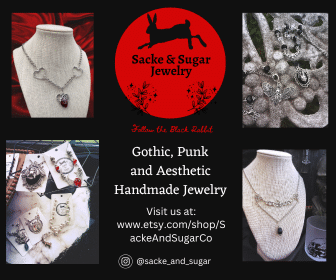
Instead of burning out though, Ejen continued and began to evolve his methods of storytelling and capturing cosplayers’ stories.
Ejen recalled, “I was looking through social media in 2012, when social media really kind of blew up, at least for cosplay and conventions. I started wondering more questions about who the [cosplayers] were, what they do, and so forth.”
Ejen was inspired to delve even deeper into cosplayers’ stories after seeing a photo project from a friend who had begun capturing personal stories relevant to their life and interests.
Ejen remarked, “He was a Japanese American kid who grew up in Los Angeles and his parents were from here, but he didn’t really know the story of the Japanese internment or incarceration, as they call it these days. So as he grew older, he got curious. That generation doesn’t really talk much about their past, and so he got involved with a local veterans group to take pictures of them. He did that first for a local organization, but he started doing this on his own because he wanted to find out more. I think he did this in a way to kind of identify with his father who was in the Korean War and passed away before he was young. Because he would talk to other veterans who knew his dad, and they would tell him stories about his dad. So I think it started from there. He went around the country for 15 years, taking pictures of veterans, Japanese American veterans who were serving the US military. And he got their story. He’s not a writer, per se. So he had another historian involved who helped out with the running down to the stories. And he actually produced two books. Now, it took him almost 20 years to do this. And the first book came out 2017 2016. So by then I read the two books, and I was helping him with his books, because he knew I did a book, so he was always asking me questions about it. And I started reading his stories. Then I started going to events like veterans reunions in Vegas. And I remember I was in Vegas and I sat next to a guy who was at Pearl Harbor. That blew my mind, because in school I read about Pearl Harbor. It’s one thing to read about it, but then to sit next to a guy who was actually at Pearl Harbor? It really blew my mind. And it just made me realize that stories are important.”
Ejen really took his new appreciation of stories, and began to focus on how he could better tell the history past and present of the cosplay community he’s been a part of all these years.
Ejen said, “I started thinking about the stories that I wanted to get from people, and it became deeper and more about who they were as people. So in a way, I was interviewing people who just happen to cosplay versus me interviewing cosplayers per se. I was trying to dig in deeper. And as time went on, I got more and more into the historical aspect of archiving and that went along with cosplay. I wanted to find out who came in before we were here, because there’s definitely generations before us.”
Ejen’s already found some enlightening discoveries in his research that really does show how even as generations come and go, there’s some similarities as one transitions to another.
Ejen remarked, “I started researching themes from the 1980s, and there was a zine I read where there was an opinion article, and the author wrote down that there’s been a disconnect between the 1970s generation, that was into sci-fi books and literature, and the new generation that grew up on sci-fi on TV and motion pictures and Star Trek and Star Wars. I thought it was very hilarious, because he was complaining about the young kids [in the 1970s] watching movies instead of reading books. And today we’re the older generation and complain about kids on TikTok or whatever that’s out there that people use to transmit their passion. I feel like we live this cycle over and over and over through history.”
Ejen’s research has taken him across many decades; however, he also is really rooted in the time and genres he came of age in and as a fan himself.
“I’m trying to find a common thread to all the stories of cosplay or costuming through the ages, but truthfully I kind of focus more on the 80s, 90s, and 2000s.” Ejen continued, “Because as a kid, I grew up watching anime as a primary hobby. I did read comic books, watch movies, and watch TV and so forth. I’m just more connected to the anime convention scene than I am to the comic book or sci-fi scenes.”
While concentrating on telling other people’s stories, Ejen’s own story took an unexpected turn with a diagnosis he was blindsided by of early onset Parkinson’s disease.
Ejen said, “I was 42 when I was diagnosed with early onset Parkinson’s disease, and I’m like “What, are you kidding me? Like, really?” So I went to another doctor, and I got the same result. And this kind of made connections to things that happened to me over the years. Like one off things that happened. I lost my sense of smell years ago, but I really didn’t think too much of it because I was so busy with life that I was just like, oh, it’s probably nothing, you know? And then weird things happened. I remember one time I was at the airport at LAX around five in the morning on my way to some convention. I was at a kiosk and I finished typing in and got my ticket and turned around and then I promptly fell down, which made no sense to me so I figured I was just half asleep because it was so early in the morning. But an early sign is that your sense of balance becomes a lot worse. And actually today if you push me there’s a good chance I’d probably fall over like, I don’t think I could catch myself.”
Ejen found himself in a dark place with the news of his diagnosis, and the pandemic only added to that feeling.
“When the pandemic happened, I felt my world was already burning,” Ejen remarked. “And so I was thinking let the world burn. I’m already in this hell. So in a way I was going through double layers of stuff at a time.”
Ejen quickly learned a lot about Parkinson’s disease, and realized how complex it can be and how it affects a variety of people in many different ways.
“It’s a very interesting disease, but I wouldn’t even call it a disease,” Ejen clarified. “I would call it a group of diseases because it affects so many things. There’s a mental aspect and a motor aspect to it, and everybody who has had experiences are different. My hand did the shakes at first, but it doesn’t do that as much anymore. The weirdest [symptom] I got is that I drool now, which may not sound like anything important, but I will catch myself like wait did I just drool on myself? That’s just one of the things that I never thought about that would happen. My eyesight and my vision is worse now too, so I don’t even drive at night because I don’t trust myself driving at night. [Plus] my reaction time is so slow. Now it actually bothers me a lot, because I have to make sure to give plenty of room around my car. So in case anything happens, then I can have enough time to hit the brakes in a timely manner. But the sense of balance is really the most jarring. Because when I put on my pants in the morning, I have to stand next to a wall just in case anything happens so I can fall against a wall.”
Ejen’s taken a step back from attending as many conventions as he used to, and part of that decision was health related but also he was initially concerned that others who hadn’t seen him in years wouldn’t recognize him as the same Ejen.
Ejen commented, “Frankly, I’m kind of embarrassed by the way that I may seem to people because I think people remember me from the videos from 15 years ago, where I was running around interviewing people and just being a con goer. And when people see me now I walk like I’m 10 years older. I move slower and I talk slower. I want people to remember me the way I was not how I turned out. At the same time [though] I realized that people would have to see this because you know this disease is actually growing. The number of young people diagnosed under the age of 50 is getting worse. I know that people go to their doctors and their doctors don’t even think about Parkinson’s as a possible reason [for their symptoms], and then that person goes through years of not knowing what they have, or spending all the money trying to figure out what it is. If there was just more awareness and more research done into the disease, because right now the medication only treats the symptoms. It doesn’t actually treat the disease at all. The diseases have been around for over 100 years, and we haven’t moved beyond much the same medication that we had since the beginning.”
Prior to his own diagnosis, Ejen had only limited exposure to anyone with Parkinson’s or working to raise awareness of Parkinson’s.
“Michael J. Fox was the only person I knew with Parkinson’s, and he’s been [raising awareness] for decades,” Ejen said. “Other than that there was a couple that actually sat next to me at Dallas Fan Expo in 2018 or 2019, and the husband was diagnosed with a disease and given a [limited] amount of time to live. One of the things he wanted to do [after the news] was build a DeLorean from Back to the Future. So he built it. Six months, nine months down the line, the doctor comes back and says, “Oops, we made a mistake.” Because he was actually getting better. So they decided to use the vehicle for benefits for charity events, because they will get stopped on the streets at stoplights by people who want to take pictures. They thought of the Michael J. Fox Foundation and working with them, and that [began] almost 20 years ago. Now they travel the country to conventions, and you may have seen them at your local conventions, where they have the DeLorean. They have the backdrop with the clock tower and you can take a picture there, and they just ask for a donation. Their donations go directly to the Michael J. Fox Foundation. They actually sat up next to me at Dallas Fan Expo, and I remember [thinking] that’s pretty admirable to be doing that. I had no idea I would be so connected within six months. So I would tell people if they see them, go get your picture and donate.”
Going through his own diagnosis with Parkinson’s and the pandemic, gave Ejen an increased appreciation at the daily and sometimes lifelong struggles people go through that may not always be so obvious.
Ejen said, “I would say [to remember] you don’t know what people are going through. People say that a lot, and I’ve been on that side, but now I’m on the other side going through this. You really don’t know what people are really going through and people should just be more understanding and kind to others and take a moment to think about other people. We are all part of the same community. I’ve been really into the kindness thing lately. I’ve been watching a lot of Instagram reels [about kindness]. There’s this guy in Canada who gives money away. He will go up to a store and say “Hey I don’t have any cash, but I would like to have something to eat.” And then he will meet these regular folks who say “Oh yeah here. Do you want a drink?” and stuff like that, and he will come back and say “You know I didn’t forget my money. It’s right here. And I would like to give you money.” The one that really got me is he gave money to an old man at a grocery store, who promptly gave part of the money to someone else in the store. He passed it on. “I was like we need more kindness in this world.”
Ejen choked up for a moment and then continued, “The world seems to get rougher and harder, and we just need to be more open with each other.”
Ejen’s comment led me back to thinking about my time in the pandemic, and I mentioned how I believe that recapturing that feeling of community after has become so important for me personally.
Ejen concurred, “I think it’s important as well, because I think there’s one thing that gets us through life [and that] is friends and family. I think that’s the secret to life. It’s the people you go on this trip with that matter the most, because at the end of the day with our life we’re going to just remember those times. The thing I like about cosplay and conventions is it’s like a group of people getting together on a journey in their lives. However short or long a time spent in the fandom, they go on a journey with friends and make experiences for themselves. And I believe it travels with them. Like with my pharmacist somehow the conversation came up about conventions, and he said “Oh I cosplay Vash the Stampede”. And I just [thought] wow, and he was my pharmacist, and see he made a connection with somebody based on the experiences he had. And I believe that cosplay will only get bigger and bigger as time goes by. Just like anime. In the old days anime was known as a weird thing. I remember the 80s [were like that.] Now, you’re weird if you don’t know what anime is. Now it’s like, “You never heard of anime?”. I mean it completely flipped.”
Ejen’s very aware of those that helped pave the way before him, and how generations continue building on the fandom for future generations.
“[Anime fandom in America] started with those who got it into the mass media in the 70s and 80s, and thanks to the people who pushed for translations.” Ejen remarked. “Cosplay costumes have been going for generations before that, but with anime it kind of grew upon itself. The foundation started with people like fan subbers. That got us to a point that we now have streaming anime on different platforms, which blows my mind. If these people didn’t do what they did, and there’s a lot of them out there that nobody really knows about, [we wouldn’t have today’s anime fandom.]”
In addition to past generations of anime fans, Ejen’s particularly curious how today’s cosplayers find community, confidence, and self-esteem through cosplay.
Ejen said, “Stories that I really gravitate towards are the ones when young people find themselves through cosplay. I wish that I was into this when I was in high school, because I was a loner in high school, I didn’t really have many friends. I think I only had two. I was reading comic books and watching anime and that was my thing. [Cosplay] was actually around when I was a kid, but I didn’t know where it was because it was before the internet. But I always gravitated towards stories where people find their identity, find their skill set, or find purpose in their life through cosplay.”
Even though cosplay was not a part of Ejen’s life growing up, he’s incredibly thankful for all it’s given him in life now.
Ejen remarked, “Cosplay has given me the ability to talk to a lot of people in a lot of places and hear a lot of stories. And that’s one thing I really do appreciate. So I’m going to treasure that for sure.”
Ejen’s working on his latest book, which revisits many of the cosplayers from his first two books, so I asked him to take a moment to reflect on Cosplay in America and what it’s meant for him in his life.
Ejen said, “Really, it’s the one thing that keeps me going in life. In the last few years, I received my Parkinson’s diagnosis, and in those times of turmoil where your life gets kind of messed up you need a life preserver. To me Cosplay in America is a life preserver. It keeps me going, because I need to think that people depend on me. I know [it may seem like a] blip on social media for people, but it keeps me busy and it keeps me occupied. It kind of saved my life. I know it just sounds [overstated], but in a way I can’t imagine my life without it. I don’t know how Ejen with no cosplay connected to them would operate? I don’t even know how that life would turn out. When I started Cosplay in America I shifted down that path, and I haven’t really gone down another path. I don’t know what’s going on the other side, but [I’ll] probably [do this] for the rest of my life.”
April is Parkinson’s Awareness Month. Every 6 minutes, someone will be diagnosed with Parkinson’s disease (PD) in the U.S. For resources on how to spread awareness of Parkinson’s disease, and to donate to research, visit: https://www.parkinson.org/parkinsons-awareness-month
